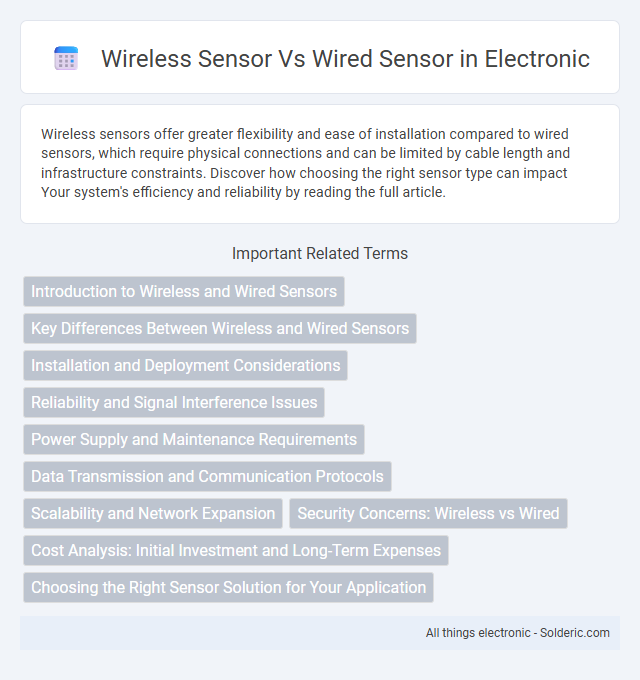Wireless sensors offer greater flexibility and ease of installation compared to wired sensors, which require physical connections and can be limited by cable length and infrastructure constraints. Discover how choosing the right sensor type can impact Your system's efficiency and reliability by reading the full article.
Comparison Table
| Feature | Wireless Sensor | Wired Sensor |
|---|---|---|
| Installation | Easy, no cables required | Complex, requires cabling |
| Mobility | High, portable and flexible | Low, fixed location |
| Cost | Higher initial cost but lower installation | Lower sensor cost but higher installation cost |
| Maintenance | Battery replacement needed | Minimal, mostly cable repair |
| Data Transmission | Wireless, potential interference | Wired, reliable and stable |
| Range | Limited by wireless signal strength | Extended, via cables |
| Application | Remote monitoring, hard-to-reach areas | Industrial automation, fixed installations |
Introduction to Wireless and Wired Sensors
Wireless sensors transmit data through radio waves, enabling flexible placement without the constraints of physical cables, ideal for remote or hard-to-access locations. Wired sensors use physical connections like cables to provide stable and less interference-prone data transmission, often preferred in environments where reliability and consistent power supply are critical. Your choice between wireless and wired sensors depends on factors such as installation environment, data transmission needs, and maintenance considerations.
Key Differences Between Wireless and Wired Sensors
Wireless sensors communicate data through radio waves, providing greater flexibility and ease of installation compared to wired sensors that rely on physical cables for data transmission. Wired sensors offer consistent power supply and faster data rates, making them ideal for environments requiring high reliability and minimal interference. In contrast, wireless sensors excel in remote or hard-to-reach locations, reducing wiring costs and enabling scalable sensor networks with potential latency and battery life trade-offs.
Installation and Deployment Considerations
Wireless sensors offer flexible installation with minimal physical infrastructure, making deployment faster and less disruptive compared to wired sensors, which require extensive cabling and fixed connections. Wireless options reduce labor costs and allow for easier repositioning, ideal for dynamic environments or hard-to-reach locations. Your choice depends on factors like network range, signal interference, and long-term maintenance requirements.
Reliability and Signal Interference Issues
Wireless sensors offer flexibility but can face reliability challenges due to signal interference from physical obstacles, electromagnetic noise, or competing wireless devices, which may cause data loss or delays. Wired sensors provide a stable connection with minimal interference, ensuring consistent and accurate data transmission even in harsh environments. Your choice depends on the criticality of data accuracy and environmental factors impacting signal quality.
Power Supply and Maintenance Requirements
Wireless sensors rely on battery power, requiring periodic replacement or recharging, which can impact maintenance frequency and costs, while wired sensors draw continuous power from connected cables, reducing the need for battery maintenance but increasing installation complexity. Maintenance of wireless sensors often involves monitoring battery health and signal reliability, whereas wired sensors primarily require inspection of connection integrity and potential cable damage. Choosing between wireless and wired sensors depends on your preference for maintenance convenience versus power supply stability and installation constraints.
Data Transmission and Communication Protocols
Wireless sensors utilize radio frequency communication protocols like Zigbee, Bluetooth, and Wi-Fi to transmit data over distances without physical connections, enabling flexible deployment in dynamic environments. Wired sensors rely on protocols such as Modbus, CAN bus, and Ethernet, providing stable, low-latency data transmission with minimal interference in controlled industrial settings. Data transmission in wireless sensors faces challenges like signal attenuation and security risks, whereas wired sensors deliver consistent high-speed communication with enhanced reliability and reduced susceptibility to electromagnetic interference.
Scalability and Network Expansion
Wireless sensors offer superior scalability and ease of network expansion compared to wired sensors due to their cable-free installation, enabling quick deployment and flexible repositioning. Network expansion in wireless sensor systems is facilitated by adding new sensor nodes without the need for extensive infrastructure modifications or additional wiring, reducing setup time and cost. Wired sensors require physical cabling for each device, limiting scalability and making network expansion more complex, costly, and time-consuming.
Security Concerns: Wireless vs Wired
Wireless sensors face higher security risks due to signal interception, hacking, and unauthorized access, making encryption and secure protocols essential for data protection. Wired sensors offer enhanced physical security since their data transmission occurs through tangible cables, reducing vulnerability to external breaches and signal interference. Choosing between wireless and wired sensors depends on the application's security needs, with wired systems favored for critical infrastructure requiring maximum data integrity.
Cost Analysis: Initial Investment and Long-Term Expenses
Wireless sensors generally have a lower initial investment compared to wired sensors due to reduced installation costs and minimal cabling requirements. Over time, wireless sensors may incur higher maintenance expenses related to battery replacements and potential connectivity issues, while wired sensors typically benefit from more stable power sources and lower ongoing operational costs. Your choice should factor in both upfront installation budgets and anticipated long-term maintenance to optimize cost efficiency for your specific application.
Choosing the Right Sensor Solution for Your Application
Wireless sensors offer flexibility and ease of installation in environments where mobility or remote monitoring is critical, utilizing technologies like Zigbee, Bluetooth, or Wi-Fi for data transmission without physical cables. Wired sensors provide more reliable and stable connections with consistent power supply, ideal for applications requiring high precision and minimal interference, often connected via Ethernet or serial communication protocols. Selecting the right sensor depends on factors such as environmental conditions, data transmission range, maintenance capabilities, and the criticality of uninterrupted data flow.
Wireless sensor vs wired sensor Infographic

 solderic.com
solderic.com